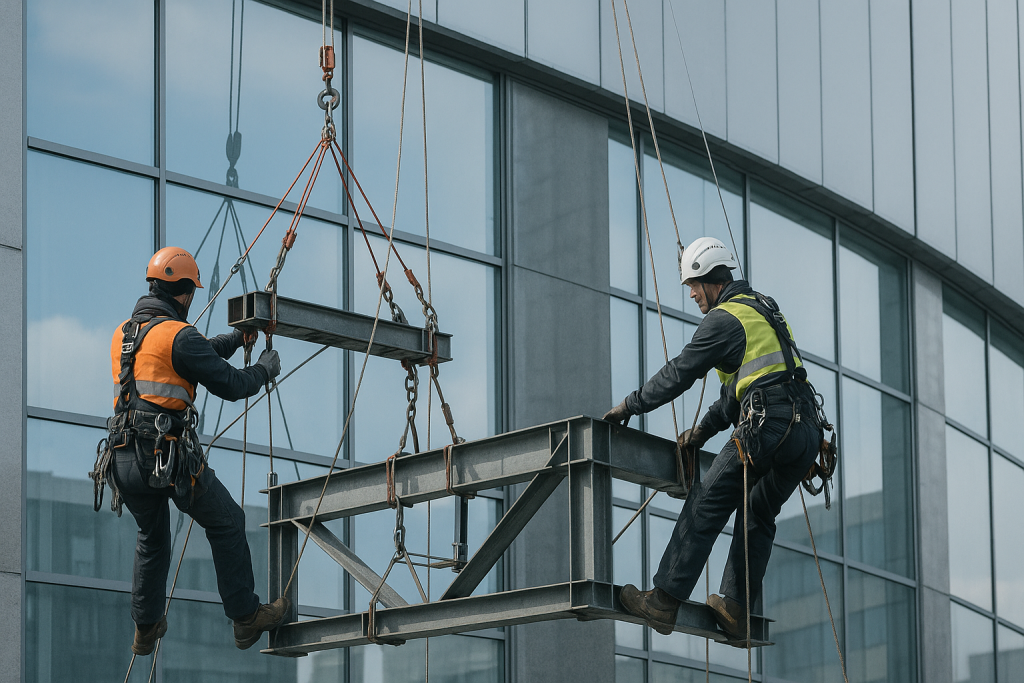How climbers assist in the assembly and dismantling of structures at height: technical aspects of lifting loads

Installation at height has always been one of the most challenging areas of construction and maintenance. Working tens of meters above the ground requires not only physical endurance, but also precise technical solutions. When it comes to dismantling structures, lifting loads, or installing new elements, it is not always possible to use standard mechanisms such as cranes or hoists. In densely built-up areas, they are often inaccessible due to limited space.
In such situations, industrial climbers. They work where heavy equipment is powerless: on roofs, facades, metal frames, or glass panels. Their training allows them to quickly organize access to the required area and perform installation or dismantling with high precision. Hiring climbers saves time and resources, as there is no need for bulky equipment or scaffolding.
Technical means of lifting loads
Successful installation at height is impossible without the right tools and systems. Industrial climbers use technical solutions that allow them to lift and secure structures of various weights and sizes. The main ones are:
- Block systems change the direction of the load and reduce the force required for lifting.
- Winches – manual or electric mechanisms for precise control of movement.
- Polispasti – multi-stage systems that reduce physical stress on workers.
- Safety systems – ropes, carabiners, ascenders, which ensure personnel safety and cargo stability.
The use of these tools allows for the efficient installation and dismantling of structures even in hard-to-reach places. For example, suction cups and cables are used for glass panels for precise positioning, and winches with increased load capacity are used for metal beams. In addition, shock-absorbing slings and modern synthetic ropes with increased strength that can withstand dynamic loads are used. This makes it possible to work not only with standard parts, but also with non-standard loads—large advertising structures, bulky metal elements, or roof equipment.
Safety during installation and dismantling
Safety is a key aspect of working at height. Installation and dismantling always involve risks, so industrial climbers operate under strict regulations, using certified equipment and control methods.
The main stages of organizing safe work include:
- Preliminary inspection of the facility – analysis of structures, determination of attachment points.
- Planning the lifting of loads – selecting tools and calculating permissible loads.
- Installation of safety systems – creation of a network of supports to protect workers.
- Work performance – controlled lifting or dismantling with continuous monitoring.
- Final inspection – checking the integrity of the installation and eliminating defects.
Special attention is paid to working with complex-shaped loads. For example, when lifting large glass elements, stabilization systems with additional attachment points are used to avoid vibrations. For heavy metal parts, dynamometric devices are used to control the load on the ropes and prevent it from exceeding the limit.
The benefits of industrial climbing for business
Mountaineering services offer businesses a number of advantages. First and foremost, they provide access to difficult areas without the need for heavy equipment. This approach reduces the cost of renting equipment and auxiliary structures. The work is carried out quickly, which is important for companies with tight deadlines.
The versatility of the methods is also a significant advantage: climbers perform installation, dismantling, lifting of loads, repair, and maintenance of various objects. These can be advertising billboards, facade repair, metal structures or large glass units. Thanks to their mobility and experience, they work even in the most difficult conditions, ensuring accuracy and reliability.
For the customer, this means faster completion times, lower costs, and the ability to implement projects without interrupting the main activities of the building. Climbers are effective both on new buildings and on facilities that have been in operation for a long time. In addition, modern equipment allows work to be carried out all year round: in summer at high temperatures and in winter in conditions of surface freezing. This makes the service consistently available and virtually universal for various business sectors.
Industrial climbers play a key role in high-altitude work. They ensure the safe and controlled lifting of loads and perform the installation and dismantling of structures where standard methods are not available. The combination of special technical equipment, professional training, and adherence to safety rules makes them indispensable specialists for businesses seeking to implement projects quickly and efficiently.
Interesting articles:
Lifting loads for installing solar panels on roofs: why climbers are the best specialists for this work
Installing cameras at height: why climbers are the best choice for installing surveillance systems
